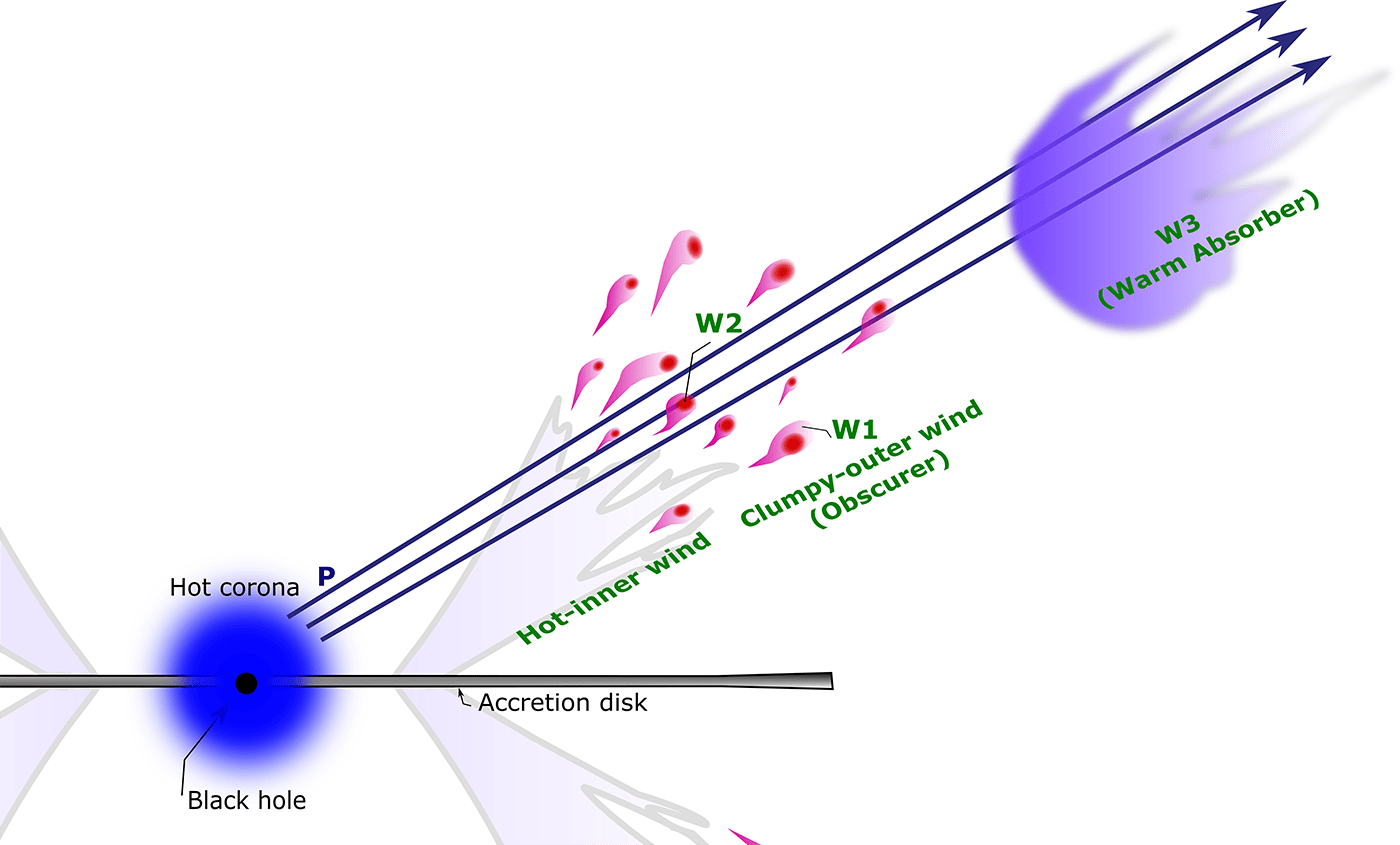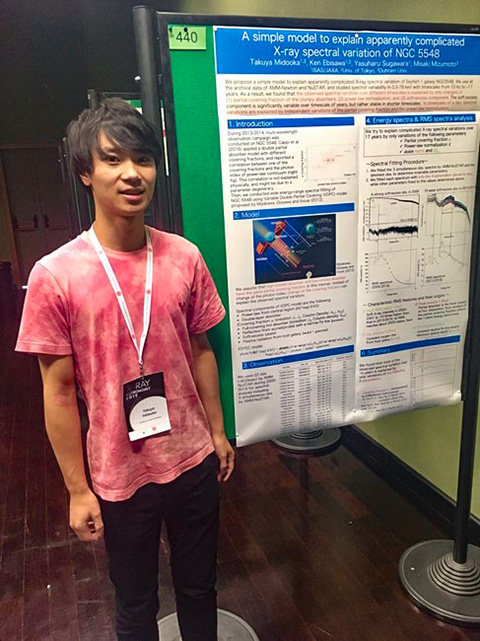Modelling the physical environment in the vicinity of a supermassive black hole at the galactic center
Sep. 26, 2022 | GATEWAY to Academic Articles
Unravelling the physical environment around the supermassive black hole at the center of a galaxy is one of the goals of modern astronomy. The brightly shining core of a galaxy is called the active galactic nucleus. X-ray observations are essential to elucidate the physical environment around the central black hole of an active galactic nucleus, as X-ray emission is particularly dominant in this region.
In this study, an active galactic nucleus NGC 5548 was studied using broadband X-ray spectra acquired by three X-ray astronomy satellites. Previous studies have used complex models to explain the X-ray spectral variability of NGC 5548, but correlations were found between parameters that could not be correlated physically. We considered this correlation to be 'parameter degeneracy' due to a model setup that included more parameters than necessary, and attempted to construct a simpler model. As a result, we succeeded in explaining the apparently complex X-ray spectral variability with a simple model of a clumpy object with a double structure crossing the line of sight.
Research Summary
The active galactic nucleus is the brightly shining central region of a galaxy. The large energy generated by the fall of matter into the supermassive black hole*1 at its center is converted into X-rays and shines brightly. Simulating the environment around the black hole, we can theoretically predict what kind of X-ray spectrum*2 will be obtained. By comparing the model spectrum obtained in this way with the observed spectrum and optimizing the model parameters so that they match, it is possible to constrain the environment near the black hole where X-rays are emitted. This is one of the most standard analysis methods in the astronomical community. However, since it is up to each researcher to determine the physical model to use for optimization, different physical models can often explain the same observed spectrum.
It is known that an accretion disk*3, corona*4, and multiple absorbers exist around the central black hole of an active galactic nucleus. On the other hand, various models have been proposed for the geometric structure and dynamical state of the corona and absorbers. Since all models can explain the observed spectra, an additional constraint, other than a fit with the observed spectra, is necessary to judge whether a model is suitable or not.
We studied NGC 5548, an active galactic nucleus, using archival data*5 acquired by three X-ray astronomy satellites. A previous study applied a model assuming two independent partial absorbers with different covering fractions to explain the complex X-ray spectral variation and reported a correlation between one of the covering fractions and the photon index*6 of the power-law continuum. However, it is not straightforward to physically understand that the photon index derived from the X-ray emission mechanism correlates with the covering fraction of absorbers far away from the corona.

Therefore, we considered this correlation to be "parameter degeneracy" caused by a model setting that included more parameters than necessary, and attempted to construct a simple spectral model. Figure 1 shows a schematic of our proposed model. As a result, we succeeded in explaining the X-ray spectral variation over 16 years without unphysical parameter correlations using a simple model in which clumpy absorbers with double structures (W1, W2 in Fig.1) partially block the line of sight and the percentage of the X-ray source covered by the clumpy absorbers change.
By examining the validity of the obtained physical parameters, we succeeded in constructing a more realistic physical model of the environment near a supermassive black hole beyond the spectral analysis. The XRISM satellite*7 is planned to obtain ultra-precise spectroscopic data in the future, and we expect that applying our proposed model to the XRISM data will confirm the consistency of our current physical picture and lead to a more realistic understanding of the physical environment.
Terminologies
- *1 supermassive black hole : A black hole with a mass being on the order of millions to billions of times the solar mass. Almost all galactic centers are thought to have such massive black holes.
- *2 X-ray spectrum : X-ray intensity distribution per energy.
- *3 accretion disk : When gas falls into the central black hole from the surroundings, a disk is formed due to the angular momentum of the gas. Depending on the radius of the accretion disk, it emits a wide range of electromagnetic waves, including optical light, ultraviolet, and X-rays.
- *4 corona : A source of X-ray radiation that exists in the vicinity of the central black hole. It is believed to be a high-temperature plasma that interacts with low-energy ultraviolet rays and X-rays to emit high-energy X-rays.
- *5 archival data : Past observation data from satellites are archived and freely available to researchers around the world. When the data become freely available varies from satellite to satellite, and in most cases, the data are only available to the person who proposed the observation for several months to several years after the observation.
- *6 photon index : A constant characterizing the shape of the power-law X-ray spectrum.
- *7 XRISM satellite : The seventh X-ray astronomy satellite project of ISAS, JAXA in cooperation with NASA and ESA, scheduled for launch in 2023.
Information
| Journal Title | Monthly Notices of the Royal Astronomical Society |
|---|---|
| Full title of the paper | Simple interpretation of the seemingly complicated X-ray spectral variation of NGC 5548 |
| DOI | https://doi.org/10.1093/mnras/stac1206 |
| Publish date | 03 May 2022 |
| Author(s) | Takuya Midooka, Ken Ebisawa, Misaki Mizumoto, Yasuharu Sugawara |
| ISAS or JAXA member(s) among author(s) | Takuya Midooka (Dept. of Astronomy, Univ. of Tokyo / Dept. of Space Astronomy and Astrophysics, ISAS), Ken Ebisawa (Dept. of Astronomy, Univ. of Tokyo / Dept. of Space Astronomy and Astrophysics, ISAS), Yasuharu Sugawara (Dept. of Space Astronomy and Astrophysics, ISAS) |


 MIDOOKA Takuya / Dept. of Astronomy, The University of Tokyo
MIDOOKA Takuya / Dept. of Astronomy, The University of Tokyo